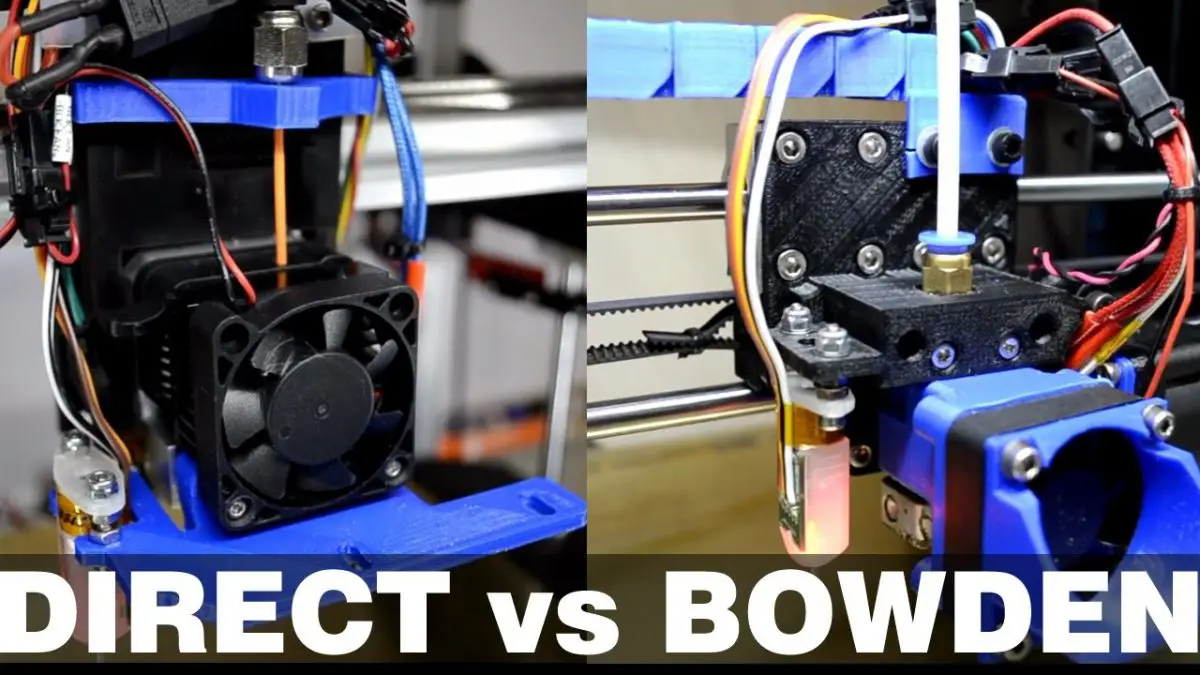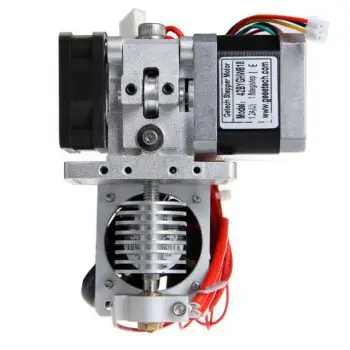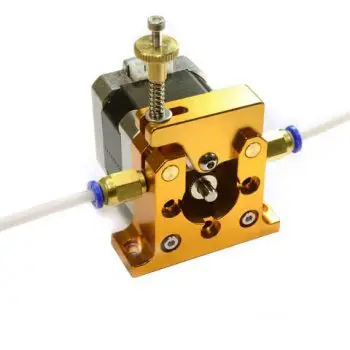
Extruders are one of the most important elements of the 3D printer and so it’s crucial that you fully understand how it works and how you can optimize it. Its core job is to push the printing filament through to the heated nozzle where it’s then melted and extruded. All extruders are constructed using the same three components and these are known as the driver gear, the stepper motor, and the idler. However, there are two types of extruders that we’ll be looking at, Direct and Bowden. The difference between the two lies in where the extruder is located and how far the filament needs to travel before it enters the heated nozzle, each design comes with its own benefits so lets look further into the Bowden vs Direct extruder discussion:

Direct Extrusion
Direct extruders are designed with a ‘direct’ path to the heated nozzle. The short space that the filament needs to travel defines the main characteristic of this type of extrusion. The direct design does come with its pros and cons so let’s have a closer look:
Pros
- Improved retraction and extrusion qualities
- Motor Size
- Filament Options
Cons
- Extra Printer Weight Head
- Takes Up Space
Direct Extruders Pros:
Improved Retraction and Extrusion Qualities
The short extruder path and direct connection with the printer head creates a better quality print. The shorter distance makes the filament more responsive and this, in turn, creates a less stringy reaction as the melting occurs.
Motor Size
Direct extruders do not require as much torque, therefore, the stepping motor component does not need to be as powerful in a standard setup. Upgrading to a larger motor with more power does offer some printing benefits, for instance, being able to push filament through faster but extra care will be needed if you go down this route.
Filament Options
The Direct extruder setup can deal with a wider range of filament materials than if you were using the Bowden setup. Abrasive materials work well, as do flexible filaments like TPE and TPU. Although you can work with flexible materials when using Bowden extruders, the direct setup will give you a better print overall.
Direct Extruders Cons
Extra Printer Head Weight
The extra weight of the Direct extruder attached to the print head can cause some printers to become unstable and frames have been known to wobble. These issues can greatly affect the quality of your end prints because the instability results in the print head struggling to move smoothly and consistently.
Takes Up Space
Unfortunately, the size of Direct extruders tend to take up most of the print head. This can become overwhelming on some printers and affect your build volume and restrict your printing potential.
Bowden Extrusion

Bowden Extruders are designed as a separate entity and so you won’t find them attached to the nozzle or the the print head like the Direct extruder. Instead, you’ll find that most of them are mounted to the printer frame itself with a Bowden tube fitted to connect the extruder and print head. The filament is then fed through the tube to the nozzle and extruded as usual. If you’re interesed in a 3D printer Bowden extruder then read on as we look deeper into the pros and cons:
Pros
- Improved Accuracy
- Faster Printing
- Bigger Build Volume
Cons
- Bigger Motor Required
- Slower Response
- Limited Materials
Bowden Extruder Pros
Improved Accuracy & Faster Printing
The location of the extruder brings the majority of the advantages to the Bowden design much like when we looked at the Direct setup. Due to the Bowden design not actually being attached to the print head means there is less pressure on the main print carriage, resulting in a smoother and faster printing process. The accuracy is also a big talking point and you will notice the higher quality of prints with a Bowden setup when using standard filament materials.
Bigger Build Volume
The great design advantage of the Bowden is that you attach it out of the way of the print head and on to the printer frame itself. This design feature allows for a smaller print head carriage resulting in more room for your 3D prints. It won’t give you tons of extra room but it will certainly be noticeable when it comes to printing larger designs.
Bowden Extruders Cons
Bigger Motor Required
A Bowden design requires more torque to push and pull the filament through the tube. The friction created as the filament is passed through the Bowden tube will cause issues. This can only be solved with a bigger and more powerful motor to control the filament material as it travels from the extruder to the print head.
Slow Response
The friction in the Bowden tube results in a slower response time which means that a Bowden setup requires faster and longer retraction settings to avoid the inevitable stringing and oozing when printing.
Limited Materials
Bowden extruders are not as forgiving as Direct extruders when it comes to the choice of materials. You can easily wear down the tubes when trying to use any type of flexible and abrasive filament so you are more restricted in what styles of print you can achieve with a Bowden design.
Which One Should You Choose?
You have several factors to think about when choosing between the Direct and Bowden setups. The stability of your printer is one of the first areas that you need to look at. A sturdy frame is required when printing with a Direct extruder and anything less will result in low-quality prints so either firm up your frame or opt for a 3d printer Bowden extruder setup.
Next, you need to ask yourself what exactly are you looking to achieve? If you’re looking for a safe bet with standard materials then use a Bowden extruder. If it’s high levels of detail you want or if you’re looking to use flexible and abrasive filament materials then your best bet is to go with a Direct extruder.
The future should hold some interesting twists and turns for these two extruder designs and we will no doubt see improvements for both setups over the coming years. The Capricorn company is currently evolving a Bowden tube that offers a better printing result with flexible filaments, so changes are coming.
For now though, the two extruder designs both have their advantages in specific situations. As long as you know what you want to achieve then you’ll have no trouble in choosing the right extruder for your 3D printing.
Recommended Reading
The Best Methods for PLA Smoothing
There are four main methods for smoothing 3D prints that we most often use, and these are also the ones that we recommend to our readers.
3D Printing Service, is it Worth it?
What is a 3D Printing Service? 3D printing services serve the purpose of helping you print anything that you like with professional input.
PETG vs PLA Filament: What’s the Difference?
What are the main advantages and disadvantages when it comes to PETG vs PLA filament? Let's jump into it!!
Extruder Calibration – is it Worth it?
You might think it's a hassle to do extruder calibrations. But what if we tell you this process has vital benefits for your printing performance?
Ender 3 Change Filament- Step-by-Step Guide
No matter which 3D printer you have though, one thing you need to learn as a 3D printer owner is how to change the filament.
Miniature Storage Solutions – A Complete Guide to Miniature Storage
We’re going to present you with miniature storage solutions for various types of collection sizes, games, and different types of minis!
